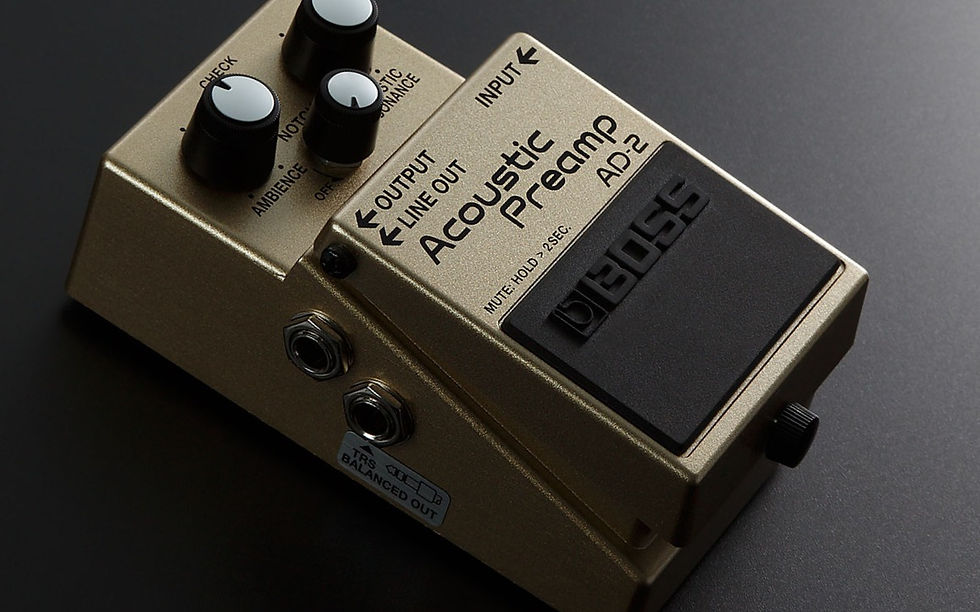Review: Disaster Area EVO Solderless Cables
- Nick Rambo
- Feb 15, 2020
- 3 min read

I tried my first solderless kit in 2009 after a couple frustrating years of failing to get standard, off-the-shelf cables to work just right with my (admittedly overcomplicated) pedalboard layout. Since that time, I’ve tried a variety of solderless offerings from most of the major players in the market, so while I wouldn’t call myself an expert, I certainly do have some experience to glean from.
Which brings us to EVO Solderless — an easy to assemble, ultra low-capacitance, ultra low-profile cabling solution that’s ideal for fully-loaded pedalboards and rack systems alike. For $59.99, you get a stylish canister filled with 10 feet of cable, 10 plugs and a screwdriver — enough supplies to make 5 cables.
[You can also get 20 plugs and 12' of cable for $99.99, or 36 plugs and 20' of cable for $179.99.]
Jack Be Nimble
The longstanding rub with solderless cables is that they can be a complete pain in the ass to assemble. Some manufacturers require stripping, crimping, clamping and threading — and it’s all very time consuming. (Not to mention a little rough on the fingers.) Plus, in my experience, these methods can be prone to user error. Meaning that you spend however long it takes to make a bunch of cables, plug them in and… bupkis. Then you’re left to hunt down, troubleshoot, repair and/or completely remake one or more cables.
EVO Solderless plugs are different.
Here’s a step by step primer on creating a cable with EVO Solderless:
Cut the cable to the right length
Firmly insert one end of cable into the opening of the plug
Tighten the ground screw
Repeat
And that’s it. Easy peasy. Done in seconds.
Plus, if you want a right angle cable, you can just bend the 0.150″ / 4mm diameter cable into the slot and you’re good to go.
Now, the one gripe I have here is with the ground screw. It’s really small. And I’ve tried several methods of trying to get it to work better, but have basically resolved to the fact that it’s just going to be just a bit tedious. But hey — at least I don’t have to run a vacuum to clean up excess copper braid anymore. And I won't miss the way my fingers get shredded by twisting the tops on at all.
On the positive side, the success rate is phenomenal. To fully wire up my board I need about 20 plugs. And as I mentioned earlier, solderless cables can be prone to user error failure. Now, your results may vary, but I was thrilled (and completely stunned) to find that I didn’t have a single cable remake the first time I wired everything up with EVO Solderless. That’s something I can’t say about any other solderless option I’ve used.
Parting Shots
These cables deliver on the Disaster Area promise: They’re small, they work impossibly well and they’re easy to assemble any time you need to make a change. I’ve been using this newest version of Disaster Area's flagship solderless system on my board for a several years now and still absolutely love them. And let me tell you — the low profile nature of the plugs makes them even more spectacular when you're trying to squeeze a pedalboard together.
The recyclable/reusable packaging is a breath of fresh air, too. Instead of throwaway plastic, it feels like the Disaster Area team went out of their way to make that element as utilitarian as the cables themselves — and that's a nice touch.
Note: An earlier version of this review was featured in Tone Report Weekly
Check out my video review here
To buy EVO Solderless, go to Disaster Area Designs



![Review: Kingsley Minstrel [v2]](https://static.wixstatic.com/media/286ec4_102acaa50c884b40bd5307c6713b6dd2~mv2.jpg/v1/fill/w_512,h_468,al_c,q_80,enc_avif,quality_auto/286ec4_102acaa50c884b40bd5307c6713b6dd2~mv2.jpg)

Experience superior sound with 3.5mm black audio cable.